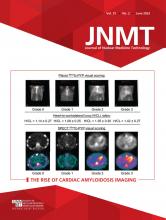Article Figures & Data
Tables
Identity Dose Route of administration 99mTc-pyrophosphate 370–740 MBq (10–20 mCi) Intravenous Parameter Characteristics Standard, optional, or preferred Camera type Large-field-of-view γ-camera Standard Cadmium zinc telluride Optional* Energy peak 140 keV Standard Energy window 15%–20% Standard Collimator Low-energy, all-purpose Standard Patient position Supine Standard Field of view Heart/chest Standard Injection-to-imaging time 3 h Standard 1 h Optional Planar Acquisition type Static Standard Whole-body imaging Optional† Detector configuration 90° Standard Views Anterior and left lateral Standard Number of views 2 Standard Counts per view 750,000 Standard Matrix 256 × 256 Standard Magnification 1.46 SPECT or SPECT/CT* Acquisition type Step and shoot or continuous Standard Patient position Supine Standard Upright Optional Orbit 180°/90° Standard 360°/180° Optional Matrix 128 × 128 (minimum, 64 × 64) Standard Magnification 1.46 (180° orbit) Standard 1.0 (360° orbit) Optional Pixel size 2.3–6.5 mm Standard Projections/detector 40/32 Standard Time/projection 20 s/25 s Standard CT attenuation correction Heart Preferred ↵* Parameters defined for γ-cameras as parameters for cadmium-zinc-telluride cameras have not been firmly established.
↵† Whole-body imaging is not performed when imaging with 99mTc-pyrophosphate. However, whole-body imaging is useful when imaging with 99mTc-HMDP or 99mTc-DPD to demonstrate soft-tissue uptake.
Grade Description 0 No myocardial uptake and normal bone uptake 1 Myocardial uptake less than rib uptake 2 Myocardial uptake equal to rib uptake 3 Myocardial uptake greater than rib uptake with mild or absent uptake







